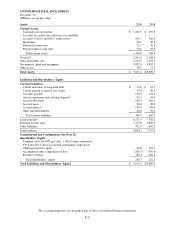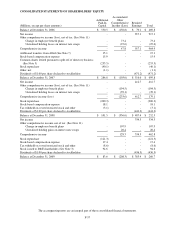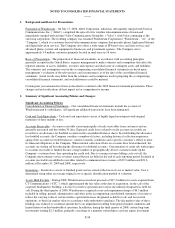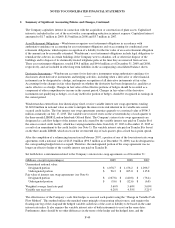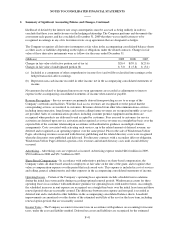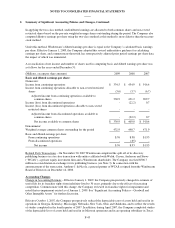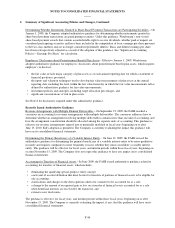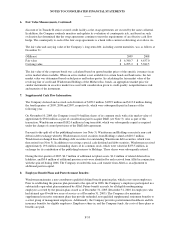Windstream 2009 Annual Report Download - page 159
Download and view the complete annual report
Please find page 159 of the 2009 Windstream annual report below. You can navigate through the pages in the report by either clicking on the pages listed below, or by using the keyword search tool below to find specific information within the annual report.
NOTES TO CONSOLIDATED FINANCIAL STATEMENTS
2. Summary of Significant Accounting Policies and Changes, Continued:
On August 28, 2009, the FASB updated the authoritative guidance for fair value measurements to clarify that in
circumstances in which a quoted price in an active market for the identical liability is not available, a reporting
entity is required to measure fair value using one or more of the following methods: 1) a valuation technique that
uses a) the quoted price of the identical liability when traded as an asset or b) quoted prices for similar liabilities
or similar liabilities when traded as assets and/or 2) a valuation technique that is consistent with fair value
measurement principles (e.g. an income approach or market approach). The amendment also clarifies that when
estimating the fair value of a liability, a reporting entity is not required to adjust to include inputs relating to the
existence of transfer restrictions on that liability. The adoption of this guidance did not impact Windstream’s
consolidated financial statements.
On September 30, 2009, the FASB updated the authoritative guidance to allow a reporting entity to measure the
fair value of certain alternative investments on the basis of net asset value per share of the investment if the net
asset value of the investment is calculated in a manner consistent with the measurement principles of investment
companies. The adoption of this guidance did not have a material impact on our consolidated financial statements.
Business Combinations – Effective January 1, 2009, Windstream adopted the revised authoritative guidance for
business combinations which establishes principles and requirements for how the acquirer in a business
combination recognizes all the assets acquired and liabilities assumed in a transaction at the acquisition-date fair
value with limited exceptions. The revised guidance changed the accounting treatment for certain specific items,
including acquisition costs, acquired contingent liabilities, restructuring costs, deferred tax asset valuation
allowances and income tax uncertainties after the acquisition date. In addition, a substantial number of new
disclosures are also required.
In April 2009, the FASB amended the authoritative guidance for subsequent business combinations to require
contingent assets acquired or liabilities assumed be initially recognized at fair value at the acquisition date if fair
value can be determined during the measurement period. If the acquisition date fair value cannot be determined,
the asset acquired or liability assumed arising from a contingency is recognized only if certain criteria are met.
This guidance also requires that a systematic and rational basis for subsequently measuring and accounting for the
assets or liabilities be developed depending on their nature. See Note 3 for a discussion of the Company’s
application of this guidance to its acquisitions of D&E Communications, Inc. (“D&E”) and Lexcom, Inc.
(“Lexcom”).
Noncontrolling Interests in Consolidated Financial Statements – On January 1, 2009, Windstream adopted
authoritative guidance for noncontrolling interests in consolidated financial statements. Windstream does not have
any non-controlling interests, and thus the adoption of this guidance did not impact the Company’s consolidated
financial statements.
Disclosures about Derivative Instruments and Hedging Activities – On January 1, 2009, Windstream adopted
authoritative guidance for disclosures about derivative instruments and hedging activities, which requires
companies with derivative instruments to disclose information to enable financial statement users to understand
how and why a company uses derivative instruments, how authoritative accounting guidance is applied to
derivative instruments and related hedged items, and how derivative instruments and related hedged items affect a
company’s financial position, financial performance and cash flows. See “Significant Accounting Policies –
Derivative Instruments” for disclosures required under this authoritative guidance.
Determination of the Useful Life of Intangible Assets – Effective January 1, 2009, Windstream adopted
authoritative guidance amending the factors that should be considered in developing renewal or extension
assumptions used to determine the useful life of a recognized intangible asset and requiring disclosures to enable
users of financial statements to assess the extent to which the expected future cash flows associated with the asset
are affected by the entity’s intent and/or ability to renew or extend the arrangement. Windstream considered its
historical experience in renewing the Company’s franchise rights and determined that it is consistent with
previous renewal assumptions used in the determination of useful lives. Thus, the adoption of this guidance did
not impact Windstream’s consolidated financial statements.
F-45


